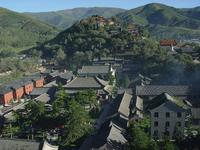You are in: Asia -> China -> Mount Wutai, and traditional search or Image Gallery will yield results of this site only
Mount Wutai
| Site number: | 1279 |
|
| Type of site: | Cultural | |
| Date: | 1st century AD | |
| Date of Inscription: | 2009 | |
| Location: | Asia, China, Shanxi province | |
Up to 75 images are shown here. Click on each for more details or on Image Gallery for more images.
| Description: | "With its five flat peaks, Mount Wutai is a sacred Buddhist mountain. The cultural landscape numbers 53 monasteries and includes the East Main Hall of Foguang Temple, the highest surviving timber Building of the Tang Dynasty with life size clay sculptures. It also features the Ming Dynasty Shuxiang Temple with a huge complex of 500 statues representing Buddhist stories woven into three dimensional pictures of mountains and water. Overall, the buildings on the site present a catalogue of the way Buddhist architecture developed and influenced palace building in China over more than one millennium. Mount Wutai, literally, the five terrace mountain, is the highest mountain in northern China and is remarkable for its morphology characterized by precipitous sides with five open treeless peaks. Temples have been built on the site since the 1st century AD to the early 20th century." --WHMNet paraphrase from the description at WHC Site, where additional information is available. | |
| Mount Wutai (Chinese: 五台山; pinyin: Wǔtái Shān; literally "Five Plateau Mountain"), also known as Wutai Mountain or Qingliang Shan, located in Shanxi, China, is one of the Four Sacred Mountains in Chinese Buddhism. The mountain is home to many of China's most important monasteries and temples. Mount Wutai's cultural heritage consist of 53 sacred monasteries, and they were inscribed as a UNESCO World Heritage Site in 2009. Each of the four mountains are viewed as the abode or place of practice (dàocháng; 道場) of one of the four great bodhisattvas. Wutai is the home of the Bodhisattva of wisdom, Manjusri or Wenshu (Traditional: 文殊) in Chinese. Mount Wutai also has an enduring relationship with Tibetan Buddhism.It takes its name from its unusual topography, consisting of five rounded peaks (North, South, East, West, Central), of which the North peak, called Beitai Ding or Yedou Feng, is the highest, and indeed the highest point in northern China. Wutai was the first of the four mountains to be identified and is often referred to as "first among the four great mountains." It was identified on the basis of a passage in the Avatamsaka Sutra (Ch: Húayán jīng; 華嚴經), which describes the abodes of many bodhisattvas. In this chapter, Manjusri is said to reside on a "clear cold mountain" in the northeast. This served as charter for the mountains identity and its alternate name "Clear Cool Mountain" (Ch: Qīngliáng Shān; 清涼山). --Wikipedia. Text is available under the Creative Commons Attribution-ShareAlike License. | ||
| Source: | http://whc.unesco.org/en/list/1279 | |
| Reference: | 1. UNESCO World Heritage Center, Site Page. | |




























